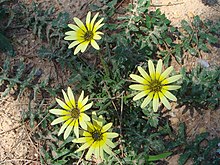Cap dandelion
| Cap dandelion | ||||||||||||
|---|---|---|---|---|---|---|---|---|---|---|---|---|

Cape dandelion ( Arctotheca calendula ) |
||||||||||||
| Systematics | ||||||||||||
|
||||||||||||
| Scientific name | ||||||||||||
| Arctotheca calendula | ||||||||||||
| ( L. ) Levyns |
The cape dandelion ( Arctotheca calendula ), also called marigold arctotheca , is a species of the sunflower family (Asteraceae).
features
The cape dandelion is an evergreen, rosette, perennial, herbaceous plant that forms underground, creeping-rooted runners and reaches heights of 30 to 60 centimeters. In southern Europe, however, the species is annual. The leaves measure 5 to 15 × 2 to 5 centimeters and are obverse-shaped, lyre-shaped, pinnate to undivided and tomentose on the underside. The flower heads are on stems 10 to 25 centimeters long. They are axillary and have a diameter of 2.5 to 4 (rarely up to 6) centimeters. The outer bracts are herbaceous with a membranous edge and often at the tip with a pinnate membranous appendage. The inner bracts are almost completely membranous and blunt. There are fewer than 20 ray florets. These are yellow to orange in color and tinted green-gray or purple on the underside. The tubular flowers are yellow, sometimes brown. The fruits are pink-brown and silky wool.
The flowering period extends from July to October. In southern Europe, however, the flowering period is March to June.
The number of chromosomes is 2n = 18.
Occurrence
The cape dandelion occurs in South Africa in Namaqualand, in Karoo and from Cape to Natal. It grows along the coast on ruderal sandy soils. In Morocco, in southern Europe, on the Azores, in Australia, New Zealand, California as well as in Argentina and Chile the kind is a neophyte.
use
The cape dandelion is rarely used as an ornamental plant for summer flower beds, rock gardens and embankments. He is a ground cover. The species has been in culture since 1739 at the latest.
literature
- Eckehart J. Jäger, Friedrich Ebel, Peter Hanelt, Gerd K. Müller (eds.): Rothmaler - excursion flora from Germany. Volume 5: Herbaceous ornamental and useful plants . Spectrum Academic Publishing House, Berlin Heidelberg 2008, ISBN 978-3-8274-0918-8 , p. 632 .
Individual evidence
- ↑ a b c Peter Schönfelder , Ingrid Schönfelder: The new cosmos Mediterranean flora. Franckh Kosmos Verlag Stuttgart 2008. ISBN 978-3-440-10742-3 . P. 92.
- ↑ a b David Allardice Webb : Arctotheca Wendl. In: Thomas Gaskell Tutin u. a .: Flora Europaea . Volume 4, page 208. Cambridge University Press 1976. ISBN 0-521-08717-1
- ^ Arctotheca calendula at Tropicos.org. In: IPCN Chromosome Reports . Missouri Botanical Garden, St. Louis
- ^ Arctotheca in the Germplasm Resources Information Network (GRIN), USDA , ARS , National Genetic Resources Program. National Germplasm Resources Laboratory, Beltsville, Maryland. Retrieved April 2, 2018.
Web links
- Thomas Meyer, Michael Hassler: Mediterranean and Alpine flora. [1]

